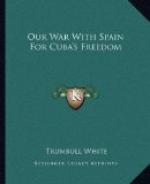The night attack was picturesque, and a striking spectacle—the crack of the Mausers, tongues of fire from every bush encircling the camp, the twitter of the long steel bullets overhead, while the machine guns down on the water were ripping open the pickets, and the crash of the field guns could be heard as they were driving in canister where the fire of the Spaniards was the thickest. Then there was the screech of the Marblehead’s shells as she took a hand in the fight, and the sharp, quick flashing of the rapid-firing one-pounder guns from the ships’ launches.
On Tuesday the brave marines, who had been exposed for three days and nights to the fire of a foe they could but blindly see, weary of a kind of warfare for which they were not trained, went into the enemy’s hiding place and inflicted disastrous punishment. The primary object of the expedition was to destroy the tank which provided the enemy with water. There are three ridges over the hills between the camp from which the Americans and their Cuban allies started and the sea. In the valley between the second and third was the water tank. The Spanish headquarters were located at cross-roads between the first and second ridges, and it was against this place that a detachment of fifty marines and ten Cubans under Lieutenants Mahoney and Magill was sent. Their instructions were to capture and hold this position. Captain Elliot with ninety marines and fifteen Cubans went east over the last range of hills, and Captain Spicer with the same number of men went to the west. A fourth party of fifty marines and a Cuban guide under command of Lieutenant Ingate made a detour and secured a position back of Lieutenant Mahoney.
The first fighting was done by the men under Lieutenant Magill with the second platoon of Company E. These parted from the others, going over the first hill to the second one. They had advanced but a short distance when they came to a heliograph station guarded by a company of Spaniards. Shooting began on both sides, the Mausers of the Spanish and the guns of the Americans snapping in unison. Our men had toiled up the hillside in the boiling sun, but they settled down to shooting as steadily and as sturdily as veterans could have done. The skirmish lasted fifteen minutes. At the end of this time the Spaniards could no longer stand the methodical, accurate shooting of Magill’s men, and they ran helter-skelter, leaving several dead upon the field. Lieutenant Magill took possession of the heliograph outfit without the loss or injury of a man.
But this was in truth only a skirmish, and the real fighting was at hand. Captains Spicer and Elliot and Lieutenant Mahoney led their men up the second range of hills. A spattering of bullets gave note that the news of their coming was abroad, but they toiled up to the top of the hill. Here they found the Spanish camp situated on a little ridge below them. There was one large house, the officers’ quarters, and around this was a cluster of huts, in the center of which was the water tank which they had come to destroy. Quickly they moved into line of battle, and advanced down the mountain, the enemy’s bullets singing viciously, but going wildly about them.




